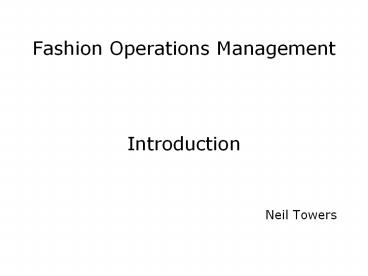Fashion Operations Management - PowerPoint PPT Presentation
1 / 14
Title:
Fashion Operations Management
Description:
Fashion Operations Management Introduction Neil Towers Fashion Operations Management Introduction Neil Towers Aspects of product and service design Marketing ... – PowerPoint PPT presentation
Number of Views:157
Avg rating:3.0/5.0
Title: Fashion Operations Management
1
Fashion Operations Management
- Introduction
- Neil Towers
2
Aspects of product and service design
Interpretation of
Expectations
expectations
Marketing
Product
Operations
or service
Customer
design
Product
Product
or service
or service
specification
3
A Typology of Operations
EXAMPLES
EXAMPLES
Electricity generator factory Gourmet
restaurant Pioneering surgery Taxi service
VISIBILITY
High
Low
4
(No Transcript)
5
Operations both
Operations
- Gives the potential for other areas to contribute
Technology
Marketing
Operations
6
(No Transcript)
7
(No Transcript)
8
Direction, extent and balance of vertical
integration
Should excess capacity be used
to supply other companies?
Raw
Component
Assembly
material
Wholesaler
Retai
ler
maker
operation
suppliers
Narrow process span
Wide process span
Up
stream
Downstream
v
ertical
v
ertical
integration
integration
9
Total and Immediate Supply Networks
Second tier Suppliers
First tier Suppliers
Second tier Customers
First tier Customers
The Operation
Supply side of the network
Demand side of the network
The Total Supply Network
The Immediate Supply Network
Internal Supply Networks
10
The operations function can provide a competitive
advantage through its performance at the five
competitive objectives
Quality
Being RIGHT
Being FAST
Speed
Dependability
Being ON TIME
Competitiveness
Flexibility
Being ABLE TO CHANGE
Cost
Being PRODUCTIVE
11
Volume-variety characteristics
Low
VOLUME
High
Low
VARIETY
Low
12
The location of operations
Supply-side
Demand-side
Operation
factors
factors
Labour costs
Labour skills
Land costs
Suitability of
site
Energy costs
Image
Transportation
costs
Convenience
for customers
Community
factors
13
Operations strategies have an ethical dimension
Product/service design - customer safety,
recyclability of
materials, energy consumption.
Network design - employment implications and
environmental
impact of location.
Layout of facilities - staff safety, disabled
customer access.
Process technology - staff safety, waste and
product disposal,
noise pollution, fumes and emissions.
Job design - workplace stress, unsocial working
hours.
Capacity planning and control - employment
policies.
Inventory planning and control - price
manipulation.
14
Five challenges for operations managers
Globalization
Social responsibility
Environmental responsibility
Knowledge management
Technology































